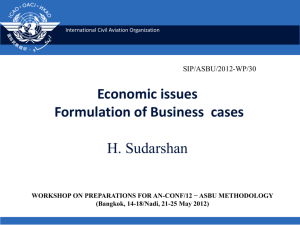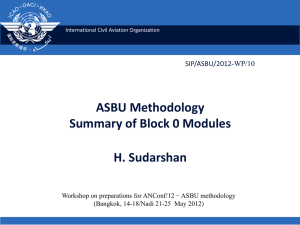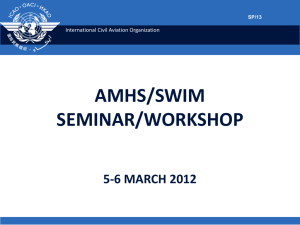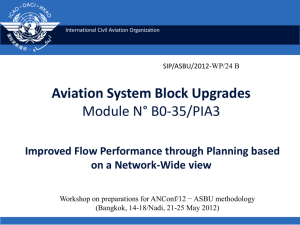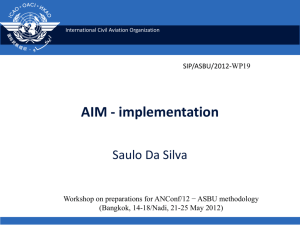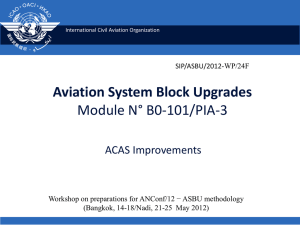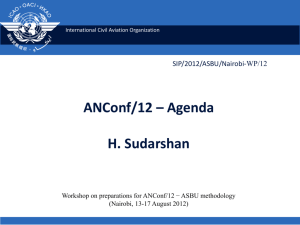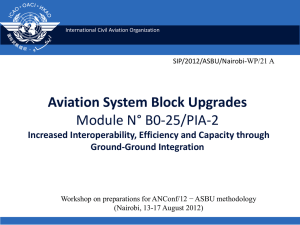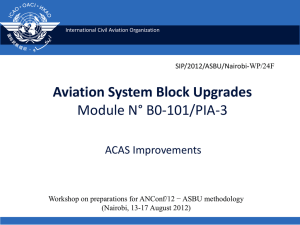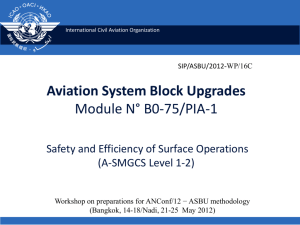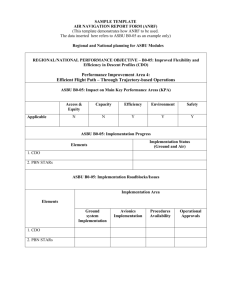Aviation System Block Upgrades (ASBU) methodology
advertisement
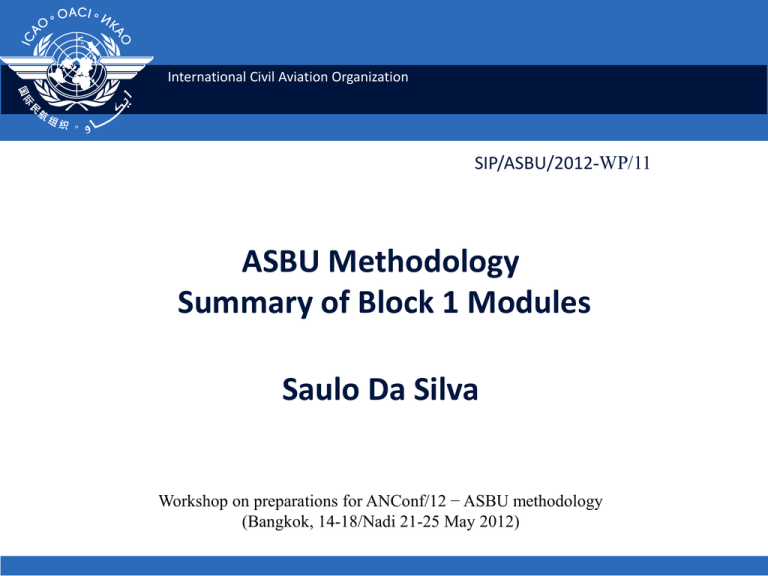
International Civil Aviation Organization SIP/ASBU/2012-WP/11 ASBU Methodology Summary of Block 1 Modules Saulo Da Silva Workshop on preparations for ANConf/12 − ASBU methodology (Bangkok, 14-18/Nadi 21-25 May 2012) Outline • • • • • Block understanding Block Maturity cycle Block 1 perspective Block 1 Modules Block 1 implementation ICAO SIP 2012-ASBU workshops 2 Block 1 Performance Improvement Areas Block 0 Block 1 Block 2 Block 3 (2013) (2018) (2023) (2028 & >) Greener Airports Globally Interoperable Systems and Data Optimum Capacity and Flexible Flights Efficient Flight Path ICAO SIP 2012- ASBU workshops 3 Block 1 • 4 Main Performance improvement areas – Greener Airports (6 modules) – Globally interoperable systems & data (4 modules) – Optimum capacity & flexible flights (4 modules) – Efficient flight path (3 modules) • Block 1 will serve as the enabler and foundation for the envisioned future aviation systems. ICAO SIP 2012- ASBU workshops 4 Block Maturity Lifecycle **** Planning Decisions based on business case and validation results as developed during the previous phase B3 B2 SIMPLIFIED LIFECYCLE V0 2018 Identification of Needs V1 V1 Concept Definition V2 V2 R&D B0 Feasibility V3 V3 Pre-Industrial Development and Integration V4 V4 Implementation Industrialisation V5 V5 Decision Operations B1 Deployment V6 V6 Decision Operations V7 V7 Decision Decommissioning Decision Standardisation activities IOC Initial Operational Capability Block 1 will see critical ANSP capabilities synchronized. ICAO SIP 2012- ASBU workshops 5 Block 1 in Perspective Performance Improvement Areas Greener Airports Globally Interoperable Systems and Data B1-30 - Service Improvement Optimum Capacity and Flexible Flights through Integration of all Digital ATM Information Efficient Flight Path B1-105 - Better Operational Decisions through Integrated Weather Information ToC B1-15 - Improved Airport operations through Departure, Surface & Arrival Management B1-35 - Enhanced Flow Performance through Network Operational Planning B1-40 - Improved Traffic Synchronisation and Initial Trajectory-Based Operation B1-85 - Increased Capacity & Flexibility through Interval Management B1-102 – Increased Effectiveness of groundbased Safety Nets B1-80 - Optimised Airport Operations through A-CDM Total Airport Management B1-75 - Enhanced Safety & Efficiency of Surface Operations (ATSA-SURF) B1-31 - Performance Improvement through the application of System Wide Information Management (SWIM) ToD B1-10 - Improved Operations through Free Routing B1-90 - Initial Integration of Remotely Piloted Aircraft (RPA) Systems into non-segregated airspace B1-05 - Improved Flexibility & Efficiency in Descent Profiles (OPDs) B1-65 - Optimised Airport Accessibility CTA B1-25 - Increased Interoperability, Efficiency & Capacity though FFICE/1 application before Departure B1-70 - Increased Runway Throughput through Dynamic Wake Turbulence Separation B1-81 - Remotely Operated Aerodrome Control Improved Airport operations through Departure, Surface and Arrival Management B1-15 Improved Airport operations through Departure, Surface and Arrival Management Summary This module includes a brief description of integrated surface management and departure sequencing. The module also summarizes the benefits of departure sequencing and its integration with surface management. Main Performance Impact KPA-04 – Efficiency; KPA-02 – Capacity; KPA-09 – Predictability; KPA-06 Flexibility Aerodrome and Terminal Runways and Terminal Maneuvering Area in major hubs and metropolitan areas will be most in need of these improvements. Domain / Flight Phases Applicability Considerations Complexity in implementation of this module depends on several factors. Some locations might have to confront environmental and operational challenges that will increase the complexity of development and implementation of technology and procedures to realize this module.PBN routes need to be in place. B0-15 B1-15 ICAO SIP 2012- ASBU workshops 7 B1-70 Increased Runway Throughput through Dynamic Wake Vortex Separation B1-70 - Increased Runway Throughput through Dynamic Wake Vortex Separation Summary This module addresses Improved throughput on departure and arrival runways through the dynamic management of wake turbulence separation minima based on the real-time identification of wake turbulence hazards. Main Performance Impact Domain / Flight Phases Applicability Considerations KPA-02 Capacity , KPA-04 Efficiency, KPA-05 Environment, KPA-06 Flexibility Aerodrome Least Complex – Implementation of re-categorized wake turbulence is mainly procedural. No changes to automation systems are needed. B1-70 B2-70 ICAO SIP 2012- ASBU workshops 8 B1-70 Increased Runway Throughput through Dynamic Wake Vortex Separation • Wake vortex separation can be reduced under certain crosswind conditions. This upgrade requires: Tactical Wind Prediction and Monitor function (for next departure) Strategic Weather function (for planning horizon) Stability of operation to ensure usability/reliability Mid Term (Block I) ICAO SIP 2012- ASBU workshops 9 B1-30 Service Improvement through Integration of all Digital ATM Information B1-30 - Service Improvement through Integration of all Digital ATM Information Summary Implementation of the ATM Information Reference Model (AIRM) integrating all ATM information using UML and enabling XML data representations and data exchange based on internet protocols. Second step of implementation of digital IM, with the WXXM for meteorological information. Main Performance Impact Domain / Flight Phases Applicability Considerations KPA-01 Access & Equity; KPA-03 Cost-Effectiveness; KPA-10 Safety All Phases of Flight Applicable at State level, with increased benefits as more States participate B1-80 B0-30 B1-30 B2-31 B1-31 B2-35 ICAO SIP 2012- ASBU workshops 10 B1-105 - Better Operational Decisions through Integrated Weather Information B1-105 - Better Operational Decisions through Integrated Weather Information Summary Main Performance Impact Domain / Flight Phases Applicability Considerations The primary goal of this module is to enable the reliable identification of applicable air traffic management (ATM) solutions when weather phenomena are impacting, or forecast to impact, aerodromes or airspace. In order to achieve this goal, full ATM-Weather Integration is necessary. ATMWeather Integration means that weather information is included in the logic of a decision process or aid such that the impact of the weather constraint is automatically calculated and taken into account when the decision is made or recommended. KPA-02 Capacity, KPA-04 Efficiency, KPA-09 Predictability, KPA-10 Safety All flight phases. Applicable to traffic flow planning, and to all aircraft operations in all domains and flight phases, regardless of level of aircraft equipage. Benefits accrue and/or costs are avoided as processes and Decision Support Tools (DSTs) employing ATM-Weather Integration concepts and techniques are adopted. B2-31 B1-105 B3-105 ICAO SIP 2012- ASBU workshops 11 B1-5 - Improved Flexibility & Efficiency in Descent Profiles (OPDs) B1-05 - Improved Flexibility & Efficiency in Descent Profiles (OPDs) Summary This module provides the baseline for using Required Navigation Performance (RNP) with Vertical Containment. Vertical RNP is the requirement on vertical system accuracy at the 99.7% probability level. It indicates the normal operating error characteristics of a navigation system. The system is designed to enhance vertical flight path precision during descent, arrival, and while in the non-precision environment and enables aircraft to fly an approach procedure not reliant on ground based equipment for vertical guidance. Main Performance Impact Domain / Flight Phases Applicability Considerations KPA-04 Efficiency Descent, Arrival, Flight in Terminal Area The baseline for this block is Improved Flight Descent Profile enabled by Block B0-5. This block is a component of Trajectory-Based Operations (TBO). B1-5 B3-5 ICAO SIP 2012- ASBU workshops 12 Challenges - How to Get There? • Budget considerations are greater for Block 1 since these modules do involve technology insertion in either ground/air or both. • Block 1 has a strong dependency on moving to network based communications for aviation. • There are regional synchronization issues of equipage and capabilities to achieve much of Block 1. This is essential to the successful implementation to the future Blocks. – Global standards can alleviate such risks and ensure interoperability between regional ANSPs. Global standards also offers stakeholders a common rubric. Aviation System Block Upgrade – Block I ICAO SIP 2012- ASBU workshops 13 ICAO SIP 2012- ASBU workshops 14
